View in other NatureServe Network Field Guides
NatureServe
Montana
Utah
Wyoming
Idaho
Wisconsin
British Columbia
South Carolina
Yukon
California
New York
Juniper Hairstreak - Callophrys gryneus
Native Species
Global Rank:
G5
State Rank:
S4
Agency Status
USFWS:
USFS:
BLM:
External Links
General Description
[From Ferris and Brown 1981; Scott 1986; Opler and Wright 1999; Glasberg 2001; Pyle 2002] Forewing 1.2-1.3 cm. Tailed. Uppersurface gray to reddish-brown, redder near tails, forewing with postmedian row of white spots in alignment, hindwing apple green to yellow-green; hindwing undersurface postmedian white line irregular and edged inwardly with red-brown, strong marginal blue and black spots in tail area.
Phenology
Two flights, late April to early June and late June to early August in northeast and Midwest; several flights southward; one flight, mostly mid-May to June in most of west, April to May on Pacific Coast (Scott 1986). Two flights in south and east, March to May and June to September; one flight in much of the west, mainly late May to early July (Glassberg 2001). Late April to August in Colorado (Scott and Scott 1978), late March to early August in Oregon and Washington (Pyle 2002), early May to late June in British Columbia (Guppy and Shepard 2001).
Diagnostic Characteristics
Best determined by association with junipers, the hindwing uppersurface apple green to yellow-green; hindwing undersurface postmedian white line irregular and edged inwardly with red-brown, strong marginal blue and black spots in tail area.
Species Range
Montana Range
Range Descriptions
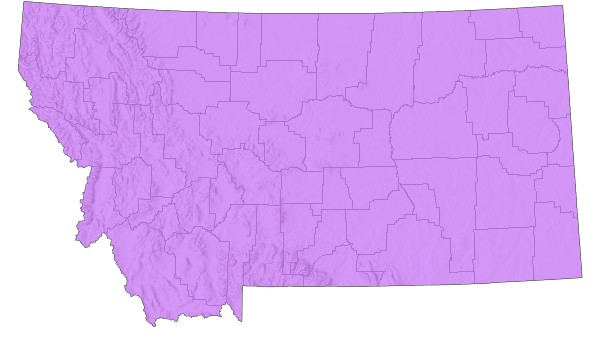
 Native
Native
Range Comments
Southern British Columbia south to southern California and northwestern Mexico, east to southern Ontario, New England and most of eastern US to northern Louisiana and Florida (Scott 1986; Opler and Wright 1999; Glassberg 2001; Pyle 2002); 1463 m to 2682 m elevation in Colorado (Scott and Scott 1978), 1830 m to 2135 m elevation in the Rocky Mountain states (Ferris and Brown 1981), 549 m to 1463 m elevation in Oregon (Warren 2005). In Montana, reported from across most of the state except the upper northwest counties (Kohler 1980; Stanford and Opler 1993). Taxonomy remains unstable and confusing, compounded by unintended introductions on host plants used in ornamental plantings (Johnson 1978). Uncommon to common (Glassberg 2001).
Observations in Montana Natural Heritage Program Database
Number of Observations: 3
(Click on the following maps and charts to see full sized version)
Map Help and Descriptions
Relative Density
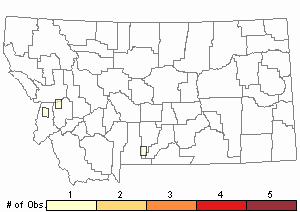
Recency
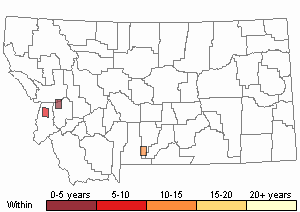
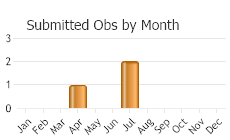
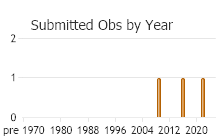
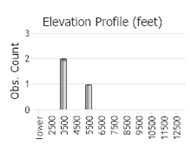 (Observations spanning multiple months or years are excluded from time charts)
(Observations spanning multiple months or years are excluded from time charts)
Migration
Non-migratory; adults may stray up to 15 km from host junipers (Scott 1986).
Habitat
Pinyon-juniper woodland, juniper forest, juniper windbreaks, juniper shrub-steppe, city parks and gardens (Scott 1986; Opler and Wright 1999; Glassberg 2001; Pyle 2002). Habitat in Montana not described but probably similar.
Food Habits
Larval food plants include multiple species of Juniperus (Johnson 1978; Ferris and Brown 1981; Scott 1986, 1992; Guppy and Shepard 2001; Pyle 2002). Adults feed on flower nectar (including Achillea, Aletes, Apocynum, Asclepias, Astragalus, Baccharis, Ceanothus, Chrysothamnus, Cirsium, Cleome, Comandra, Conium, Cryptantha, Eriogonum, Erysimum, Euphorbia, Geranium, Harbouria, Heterotheca, Hymenopappus, Jamesia, Melilotus, Mimulus, Opuntia, Phacelia, Phlox, Physocarpus, Potentilla, Prunus, Rhus, Rubus, Rudbeckia, Salix, Schoenocrambe, Sedum, Senecio, Solidago, Trifolium, Veronica) and mud (Scott 2014).
Reproductive Characteristics
Females lay eggs singly on host plant foliage tips and flowering twigs (Scott 1986; Pyle 2002). Eggs hatch in about 8-10 days, develop to L4 instar and pupation in about 30 days post-hatch (depending on temperature). Larvae are solitary, feed on juniper needles, build no nest, depart host plant as mature larvae prior to pupation, pupate in litter, overwinter (hibernate) as pupae (Scott 1979; James and Nunnallee 2011). Males perch throughout the day on the tops and sides of juniper trees, more often on ridge crests than in valleys, to await passage of females (Scott 1975b, 1986).
References
- Literature Cited AboveLegend:
 View Online Publication
View Online Publication Ferris, C.D. and F.M. Brown (eds). 1981. Butterflies of the Rocky Mountains. Univ. of Oklahoma Press. Norman. 442 pp.
Ferris, C.D. and F.M. Brown (eds). 1981. Butterflies of the Rocky Mountains. Univ. of Oklahoma Press. Norman. 442 pp. Glassberg, J. 2001. Butterflies through Binoculars: A Field Guide to the Butterflies of Western North America. Oxford University Press.
Glassberg, J. 2001. Butterflies through Binoculars: A Field Guide to the Butterflies of Western North America. Oxford University Press. Guppy, C.S. and J.H. Shepard. 2001. Butterflies of British Columbia: including western Alberta, southern Yukon, the Alaska Panhandle, Washington, northern Oregon, northern Idaho, northwestern Montana. UBC Press (Vancouver, BC) and Royal British Columbia Museum (Victoria, BC). 414 pp.
Guppy, C.S. and J.H. Shepard. 2001. Butterflies of British Columbia: including western Alberta, southern Yukon, the Alaska Panhandle, Washington, northern Oregon, northern Idaho, northwestern Montana. UBC Press (Vancouver, BC) and Royal British Columbia Museum (Victoria, BC). 414 pp. James, D.G. and D. Nunnallee. 2011. Life histories of Cascadia butterflies. Corvallis, OR: Oregon State University Press. 447 p.
James, D.G. and D. Nunnallee. 2011. Life histories of Cascadia butterflies. Corvallis, OR: Oregon State University Press. 447 p. Johnson, K. 1978. Specificity, geographic distributions, and foodplant diversity in four Callophrys (Mitoura) (Lycaenidae). Journal of the Lepidopterists' Society 32(1): 3-19.
Johnson, K. 1978. Specificity, geographic distributions, and foodplant diversity in four Callophrys (Mitoura) (Lycaenidae). Journal of the Lepidopterists' Society 32(1): 3-19. Kohler, S. 1980. Checklist of Montana Butterflies (Rhopalocera). Journal of the Lepidopterists' Society 34(1): 1-19.
Kohler, S. 1980. Checklist of Montana Butterflies (Rhopalocera). Journal of the Lepidopterists' Society 34(1): 1-19. Opler, P.A. and A.B. Wright. 1999. A field guide to western butterflies. Second edition. Peterson Field Guides. Houghton Mifflin Company, Boston, Massachusetts. 540 pp.
Opler, P.A. and A.B. Wright. 1999. A field guide to western butterflies. Second edition. Peterson Field Guides. Houghton Mifflin Company, Boston, Massachusetts. 540 pp. Pyle, R.M. 2002. The butterflies of Cascadia: a field guide to all the species of Washington, Oregon, and surrounding territories. Seattle Audubon Society, Seattle, Washington. 420 pp.
Pyle, R.M. 2002. The butterflies of Cascadia: a field guide to all the species of Washington, Oregon, and surrounding territories. Seattle Audubon Society, Seattle, Washington. 420 pp. Scott, J.A. 1975b. Mate-locating behavior of western North American butterflies. Journal of Research on the Lepidoptera 14:1-40.
Scott, J.A. 1975b. Mate-locating behavior of western North American butterflies. Journal of Research on the Lepidoptera 14:1-40. Scott, J.A. 1979. Hibernal diapause of North American Papilionoidea and Hesperioidea. Journal of Research on the Lepidoptera 18(3): 171-200.
Scott, J.A. 1979. Hibernal diapause of North American Papilionoidea and Hesperioidea. Journal of Research on the Lepidoptera 18(3): 171-200. Scott, J.A. 1986. The butterflies of North America: a natural history and field guide. Stanford University Press, Stanford, California.
Scott, J.A. 1986. The butterflies of North America: a natural history and field guide. Stanford University Press, Stanford, California. Scott, J.A. 1992. Hostplant records for butterflies and skippers (mostly from Colorado) 1959-1992, with new life histories and notes on oviposition, immatures, and ecology. Papilio new series #6. 185 p.
Scott, J.A. 1992. Hostplant records for butterflies and skippers (mostly from Colorado) 1959-1992, with new life histories and notes on oviposition, immatures, and ecology. Papilio new series #6. 185 p. Scott, J.A. 2014. Lepidoptera of North America 13. Flower visitation by Colorado butterflies (40,615 records) with a review of the literature on pollination of Colorado plants and butterfly attraction (Lepidoptera: Hersperioidea and Papilionoidea). Contributions of the C.P. Gillette Museum of Arthopod Diversity. Fort Collins, CO: Colorado State University. 190 p.
Scott, J.A. 2014. Lepidoptera of North America 13. Flower visitation by Colorado butterflies (40,615 records) with a review of the literature on pollination of Colorado plants and butterfly attraction (Lepidoptera: Hersperioidea and Papilionoidea). Contributions of the C.P. Gillette Museum of Arthopod Diversity. Fort Collins, CO: Colorado State University. 190 p. Scott, J.A. and G.R. Scott. 1978. Ecology and distribution of the butterflies of southern central Colorado. Journal of Research on the Lepidoptera 17(2): 73-128.
Scott, J.A. and G.R. Scott. 1978. Ecology and distribution of the butterflies of southern central Colorado. Journal of Research on the Lepidoptera 17(2): 73-128. Stanford, R.E. and P.A. Opler. 1993. Atlas of western USA butterflies: including adjacent parts of Canada and Mexico. Unpubl. Report. Denver and Fort Collins, Colorado 275 pp.
Stanford, R.E. and P.A. Opler. 1993. Atlas of western USA butterflies: including adjacent parts of Canada and Mexico. Unpubl. Report. Denver and Fort Collins, Colorado 275 pp. Warren, A.D. 2005. Lepidoptera of North America 6: Butterflies of Oregon, their taxonomy, distribution, and biology. Contributions of the C. P. Gillette Museum of Arthropod Diversity, Colorado State University. Fort Collins, Colorado. 406 pp.
Warren, A.D. 2005. Lepidoptera of North America 6: Butterflies of Oregon, their taxonomy, distribution, and biology. Contributions of the C. P. Gillette Museum of Arthropod Diversity, Colorado State University. Fort Collins, Colorado. 406 pp.
- Additional ReferencesLegend:
 View Online Publication
View Online Publication
Do you know of a citation we're missing? Allen, T.J., J.P. Brock, and J. Glassberg. 2005. Caterpillars in the field and garden: a field guide to the butterfly caterpillars of North America. Oxford University Press.
Allen, T.J., J.P. Brock, and J. Glassberg. 2005. Caterpillars in the field and garden: a field guide to the butterfly caterpillars of North America. Oxford University Press. Brock, J.P. and K. Kaufman. 2003. Kaufman Field Guide to Butterflies of North America. Houghton Mifflin Company, New York, NY 284 pp.
Brock, J.P. and K. Kaufman. 2003. Kaufman Field Guide to Butterflies of North America. Houghton Mifflin Company, New York, NY 284 pp. Forister, M.L., E.M. Grames, C.A. Halsch, K.J. Burls, C.F. Carroll, K.L. Bell, J.P. Jahner, et al. 2023. Assessing risk for butterflies in the context of climate change, demographic uncertainty, and heterogeneous data sources. Ecological Monographs 93(3):e1584. https://doi.org/10.1002/ecm.1584
Forister, M.L., E.M. Grames, C.A. Halsch, K.J. Burls, C.F. Carroll, K.L. Bell, J.P. Jahner, et al. 2023. Assessing risk for butterflies in the context of climate change, demographic uncertainty, and heterogeneous data sources. Ecological Monographs 93(3):e1584. https://doi.org/10.1002/ecm.1584 Layberry, R.A., P.W. Hall, and J.D. LaFontaine. 1998. The Butterflies of Canada. University of Toronto Press. 280 pp. + color plates.
Layberry, R.A., P.W. Hall, and J.D. LaFontaine. 1998. The Butterflies of Canada. University of Toronto Press. 280 pp. + color plates.
- Web Search Engines for Articles on "Juniper Hairstreak"
- Additional Sources of Information Related to "Insects"





